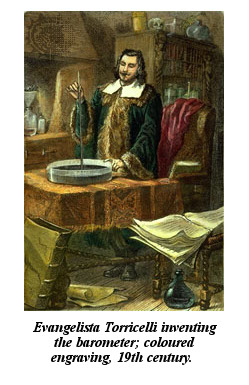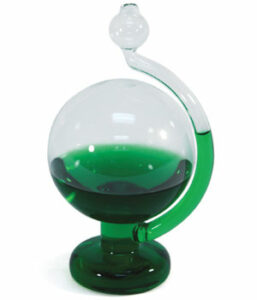
by Ted Beyer
Predicting the weather is an age-old guessing game.
Over time, more and more sophisticated devices have been developed to aid in the guessing game. Indeed, some of the largest computers in the world today are dedicated to modeling the weather using millions of data points collected all over the world—all in an effort to determine if going to the beach this weekend is a good idea, or if you should just stay home and binge watch Game of Thrones (again).
 After temperature, one of the earliest scientific observations about the weather is the variation in barometric pressure. Local changes in air pressure usually signal changes in the weather. Falling pressure generally indicates rain, snow or wind storms, and increasing pressure most often indicates nicer weather.
After temperature, one of the earliest scientific observations about the weather is the variation in barometric pressure. Local changes in air pressure usually signal changes in the weather. Falling pressure generally indicates rain, snow or wind storms, and increasing pressure most often indicates nicer weather.
One of the earliest gadgets used to try and track barometric pressure was the Weather Glass, also known as the Goethe Barometer [1]. Evangelista Toricelli [2] came up with the first truly accurate barometer—the classic, mercury-filled device—sometime around 1643-44. [Note: Educational Innovations has a mercury-free version of this Science classroom “must-have.”]
No one is quite sure who came up with the water-filled Weather Glass we are discussing here, but we do know that it first appeared in Holland around 1619, and it is said to have made the trip on the Mayflower with the Pilgrims in 1620. It was subsequently widely popularized by Johann Wolfgang Von Goethe, and so his name eventually got stuck to it.
So what is this weather glass, and how does it work?
In essence, it is nothing more than a sealed container half filled with water, with a narrow spout connected to the container at a point below the level of the water. That spout rises to a level higher than the water in the main container, and is open at the top. A small pocket of air is trapped in the container above the level of the water.
The theory goes that when the atmospheric pressure is lower than it was at the time the air pocket was trapped, the water level in the spout will rise above the water level in the body and when the atmospheric pressure is higher, the water level in the spout will drop below the water level in the container.
 Of course there is an Achilles heel to the Weather Glass—namely, temperature. As the temperature rises, the trapped pocket of air will expand. As the temperature drops, it will contract. This moves the level of the liquid up and down independent of the barometric pressure we are trying to measure. Of course, compensation charts can be developed, but this flaw in the design caused the Weather Glass to have a fairly short life in the laboratory. Still, it was an important tool for the general public—farmers and sailors especially—since it could give a rough idea of the impending weather at a very low cost. Thus it was used for many decades. In fact, Weather Glasses were still in use beyond the 19th century in many homes.
Of course there is an Achilles heel to the Weather Glass—namely, temperature. As the temperature rises, the trapped pocket of air will expand. As the temperature drops, it will contract. This moves the level of the liquid up and down independent of the barometric pressure we are trying to measure. Of course, compensation charts can be developed, but this flaw in the design caused the Weather Glass to have a fairly short life in the laboratory. Still, it was an important tool for the general public—farmers and sailors especially—since it could give a rough idea of the impending weather at a very low cost. Thus it was used for many decades. In fact, Weather Glasses were still in use beyond the 19th century in many homes.
Educational Innovations’ Weatherglass Barometer (BAR-130) is our modern take on this old workhorse, and features a fun, interesting design.
The spout is long enough for you to make marks on it with a grease pencil to record the position of the water over time. Our 21st century, climate-controlled homes and classrooms help to limit the effects of temperature on your observations, making the Weatherglass Barometer even more useful than in bygone days.
You and your students can track the height of the water daily—or even several times a day—and compare your predictions to the weather outside. On days where the weather is changing rapidly, you may be able to note barometric changes every hour, or even more frequently. You might want to consider placing a thermometer next to the Weatherglass Barometer and tracking both at the same time to try and mitigate (or at least recognize) variations in the water level created by changes in temperature.
Challenge your class with questions like:
- How accurate is the Weatherglass Barometer?
- Can you predict your next snow day?
– – – – – – – – – –
[1] Some people also refer to it as a Storm Glass, but that name is usually reserved for another apparatus which is completely sealed, contains a cocktail of chemistry, works (or tries to—science has shown that it really is just a really odd thermometer) in an entirely different way, so let’s just not go there.
[2] An Italian Physicist who lived from 1608 – 1647
Unfortunately, we put too much liquid into the container so that it’s too high in the tube to be useful. Can you send directions on how to set up this experiment correctly? We no longer have the instructions.
Thanks!
Hi Rita,
Someone from Customer Service should have sent out what you needed. Enjoy!
I also need directions on how to set up my barometer. Enough water has evaporated out (or overflowed) that it needs to be re-done. Thanks
Give us a call at 203-748-3224 and one of our customer service reps will send you another copy of the instructions.
You are right about temperature! Just put three fingers on the bulb and watch the level go up in the tube! But you are also right about modern houses. The temperature is far more steady than outside, so the effect of temperature change is less than it would have been in years gone by. The general rule is that if the level in the tube rises, either the atmospheric pressure has fallen or the temperature has risen. Conversely, a fall in the tube level means rising atmospheric pressure or falling temperature. Combine these with observations of the sky and you are ion business. With some practice, these things are handy devices that will last for many years.